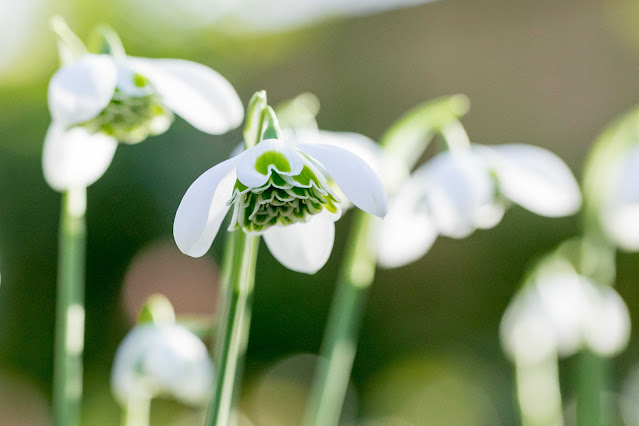Snowdrops (galanthus) evoke so much excitement that a name has been christened for people who passionately collect them - galanthophiles. I don’t consider myself in that league, but in recent years I
have come to appreciate the differences in their flower forms and have very gradually been adding to our little assortment.
 |
| Galanthus nivalis, the common snowdrop |
There can be no doubt
that these diminutive flowers bring us joy out of all proportion to their size at a time of year when little else is in flower. They are also incredibly resilient to the worst that the weather can throw at them - I watched from my kitchen window as they were buffeted by the recent high winds from storms Dudley, Eunice, and Franklin with barely a scratch.
 |
Galanthus nivalis. Photo by Pete Stevens @creativeempathy.com
|
My small collection started with our common snowdrop, Galanthus nivalis. The name is derived from two Greek words: 'gala' meaning milk and 'anthos' meaning flower. Nivalis is a Latin word meaning 'of the snow'. Very apt as they are so at home in the wintry months - can there be a sight more heart-warming than their dainty heads poking out above a carpet of snow?
 |
| Galanthus nivalis in the snow. Photo by Pete Stevens @creativeempathy.com |
I bought both dry bulbs and bulbs 'in the green', which are plants that have just finished flowering. I had success with both, but I prefer planting snowdrops in the green as I find them easier to arrange in natural-looking clumps. I have an unconscious habit of arranging dry bulbs in a grid pattern, no matter how hard I try for a random distribution.
Snowdrops can be grown from seed with considerable patience - it takes around four years for a seed to produce a flower. In our garden we have allowed nature to take its course and single flowers have popped up in unexpected places. The seeds have an oil-rich substance attached which is attractive to ants, who take it back to their nest, eat the substance and discard the seed. Sadly, no seedlings to excite a galanthophile have emerged - yet!
 |
Galanthus nivalis and Crocus tommasinianus
Photo by Pete Stevens @creativeempathy.com |
The quickest and easiest way to increase your collection of snowdrops is to allow them to form a large clump, dig them up, carefully divide them into smaller clumps and then replant them. Do this after they have finished flowering. I started with 500 bulbs of Galanthus nivalis in the green and over five or six years and with regular dividing they have multiplied at least three-fold.
 |
| Galanthus Colossus. Large flowers and thick leaves |
 |
Galanthus Washfield Wareham
A very late flowering snowdrop that has only just started to open |
Three 'in the green' bulbs of Galanthus Wasp arrived in the post a few days ago, a snowdrop with very long slender outer petals that I have been lusting after for a couple of years. I will plant them on the slope underneath our Magnolia x loebneri Leonard Messel, in company with Brenda Troyle, Colossus and Trymposter. Now its time to put the catalogues away until next year!














No comments:
Post a Comment